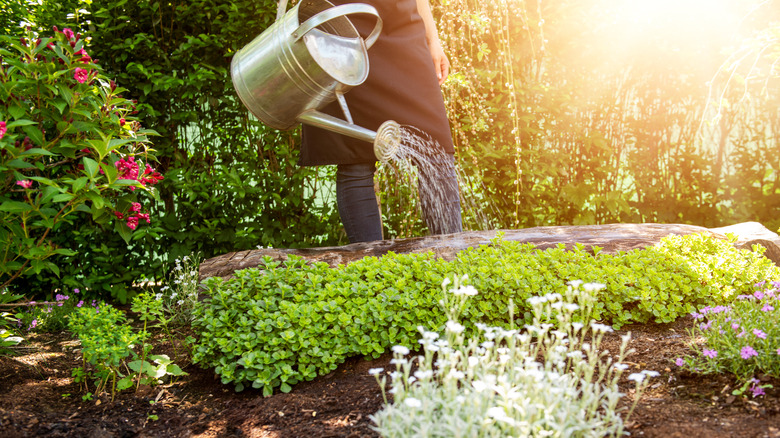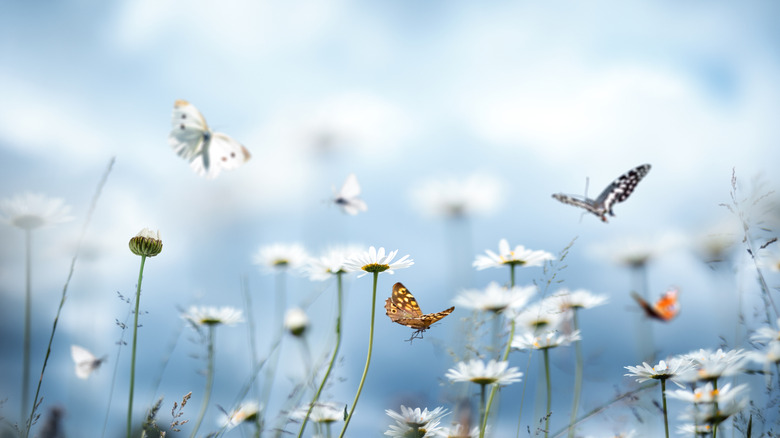The Butterfly-Friendly Ground Cover You'll Want To Plant For Continuous Summer Blooms
While not everyone likes having spontaneous human visitors, fluttery friends of the bird or butterfly variety may sound a lot more exciting to many. If you are always looking for ways to attract butterflies to your garden, as well as encourage other winged friends to come by, there may be one ground cover species you need to add to your collection. Whether you've heard of miniature daisy (Bellium minutum) or not, this plant offers blooms that keep coming all through summer along with a variety of other perks. During an exclusive interview with Dr. Kevin Folta, Professor at University of Florida, the research scientist shared with House Digest readers why the miniature daisy is a good option for those wanting to bring in pollinators and get a ground cover option that can thrive in a variety of areas. According to Dr. Folta, "The blooms attract a variety of pollinators, but the rich nectar and pollen are mostly sought out by butterflies and bees."
Dr. Folta also noted that "Miniature daisy is known for its ability to tolerate many soil types, as long as there is moisture." This allows people in many different areas to grow this species and enjoy the benefits it offers. He explained that the blooms can thrive in clay and even sand, adding that "the miniature daisy is cold and freeze tolerant, so it may be grown between USDA zones 5 and 9 as an annual."
Keep your soil and water schedule in mind
Whether you've been wondering what are ground covers and do you need them, or been trying to find ground cover that will last longer than just a season, Dr. Kevin Folta noted that miniature daisy might work for you and help keep your garden full throughout the year. He exclusively told House Digest, "In warmer zones it will continue to spread and flower almost all year." However, he shared, "The downside is that they have to be kept moist and don't tolerate dry conditions." So, if you do decide to try planting Bellium minutum, he recommended keeping the soil from drying out to ensure this plant thrives and survives all weather and temperature if it can grow in your zones.
To properly care for this ground cover, Dr. Folta noted, "The plants need to be watered every three to four days, and a slow release fertilizer helps to maintain spreading and flowering. Removing the old flowers will encourage the production of new ones." It's always good to help clear up space on both the stems and around the flowers to give them room to grow, so keep this in mind when tending to your garden and make sure you are keeping these blooms clear of excess or older growth.
Blooms that bring in pollinators
There's more to taking care of your Bellium minutum than just staying on top of your soil levels, though. Dr. Kevin Folta explained, "There are dozens of places online that sell the miniature daisy, but it is common at most nurseries throughout the growing zones." Once you've found your seeds, it's important to have the best growing conditions. During his exclusive House Digest interview, Dr. Folta offered advice to help readers grow their miniature daises, noting, "Plants should be planted in a well draining potting mix that remains moist, but not soaked, and slightly acidic is preferred."
When finding a good location in your garden to start your ground cover, you want to pick somewhere that has sun exposure, as this species needs plenty to bloom and grow. Unlike ground cover plants that prefer shade, Dr. Folta recommended giving flowers as much sun exposure as you can, keeping them in a sunny area. However, partial exposure can still allow them to grow. He added, "Individual plants are 12 to 16 inches across, and they will gradually spread by runners even further." Once your plants are blooming, you should expect to see your pollinators coming by to indulge in the flowers!


